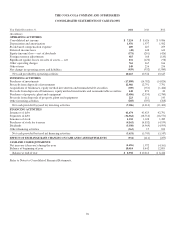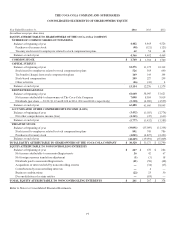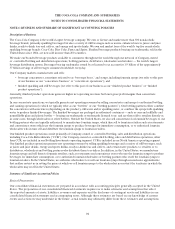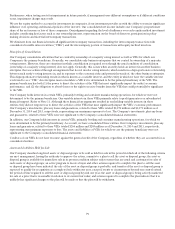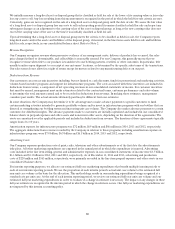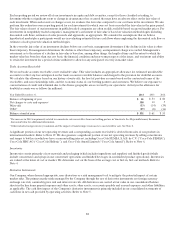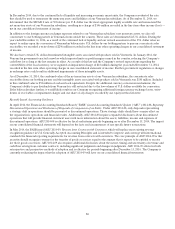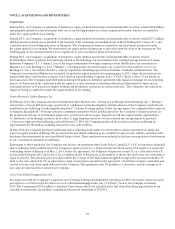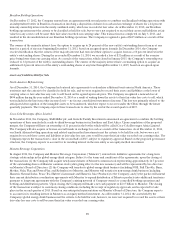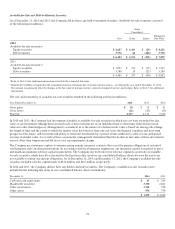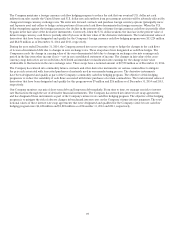Coca Cola 2014 Annual Report Download - page 87
Download and view the complete annual report
Please find page 87 of the 2014 Coca Cola annual report below. You can navigate through the pages in the report by either clicking on the pages listed below, or by using the keyword search tool below to find specific information within the annual report.85
Income Taxes
Income tax expense includes United States, state, local and international income taxes, plus a provision for U.S. taxes on undistributed
earnings of foreign subsidiaries not deemed to be indefinitely reinvested. Deferred tax assets and liabilities are recognized for the tax
consequences of temporary differences between the financial reporting basis and the tax basis of existing assets and liabilities. The tax
rate used to determine the deferred tax assets and liabilities is the enacted tax rate for the year and manner in which the differences
are expected to reverse. Valuation allowances are recorded to reduce deferred tax assets to the amount that will more likely than not
be realized. The Company records taxes that are collected from customers and remitted to governmental authorities on a net basis in
our consolidated statements of income.
The Company is involved in various tax matters, with respect to some of which the outcome is uncertain. We establish reserves to
remove some or all of the tax benefit of any of our tax positions at the time we determine that it becomes uncertain based upon one of
the following conditions: (1) the tax position is not “more likely than not” to be sustained, (2) the tax position is “more likely than not”
to be sustained, but for a lesser amount, or (3) the tax position is “more likely than not” to be sustained, but not in the financial period
in which the tax position was originally taken. For purposes of evaluating whether or not a tax position is uncertain, (1) we presume
the tax position will be examined by the relevant taxing authority that has full knowledge of all relevant information; (2) the technical
merits of a tax position are derived from authorities such as legislation and statutes, legislative intent, regulations, rulings and case law
and their applicability to the facts and circumstances of the tax position; and (3) each tax position is evaluated without consideration
of the possibility of offset or aggregation with other tax positions taken. A number of years may elapse before a particular uncertain
tax position is audited and finally resolved or when a tax assessment is raised. The number of years subject to tax assessments varies
depending on the tax jurisdiction. The tax benefit that has been previously reserved because of a failure to meet the “more likely than
not” recognition threshold would be recognized in our income tax expense in the first interim period when the uncertainty disappears
under any one of the following conditions: (1) the tax position is “more likely than not” to be sustained, (2) the tax position, amount,
and/or timing is ultimately settled through negotiation or litigation, or (3) the statute of limitations for the tax position has expired.
Refer to Note 14.
Translation and Remeasurement
We translate the assets and liabilities of our foreign subsidiaries from their respective functional currencies to U.S. dollars at the
appropriate spot rates as of the balance sheet date. Generally, our foreign subsidiaries use the local currency as their functional
currency. Changes in the carrying value of these assets and liabilities attributable to fluctuations in spot rates are recognized in
foreign currency translation adjustment, a component of AOCI. Refer to Note 15. Income statement accounts are translated using the
monthly average exchange rates during the year.
Monetary assets and liabilities denominated in a currency that is different from a reporting entity’s functional currency must first
be remeasured from the applicable currency to the legal entity’s functional currency. The effect of this remeasurement process is
recognized in the line item other income (loss) — net in our consolidated statements of income and is partially offset by the impact of
our economic hedging program for certain exposures on our consolidated balance sheets. Refer to Note 5.
Hyperinflationary Economies
A hyperinflationary economy is one that has cumulative inflation of 100 percent or more over a three-year period. In accordance with
accounting principles generally accepted in the United States, local subsidiaries in hyperinflationary economies are required to use
the U.S. dollar as their functional currency and remeasure the monetary assets and liabilities not denominated in U.S. dollars using
the rate applicable to conversion of a currency for purposes of dividend remittances. All exchange gains and losses resulting from
remeasurement are recognized currently in income.
Venezuela has been designated as a hyperinflationary economy. In February 2013, the Venezuelan government devalued its currency
to an official rate of exchange (“official rate”) of 6.3 bolivars per U.S. dollar. At that time, the Company remeasured the net monetary
assets of our Venezuelan subsidiary at the official rate. As a result of the devaluation, we recognized a loss of $140 million from
remeasurement in the line item other income (loss) — net in our consolidated statement of income.
Beginning in the first quarter of 2014, the Venezuelan government recognized three legal exchange rates to convert bolivars to the
U.S. dollar: (1) the official rate of 6.3 bolivars per U.S. dollar; (2) SICAD 1, which is available to foreign investments and designated
industry sectors to exchange a limited volume of bolivars for U.S. dollars using a bid rate established at weekly auctions; and
(3) SICAD 2, which applies to transactions that do not qualify for either the official rate or SICAD 1. As of March 28, 2014, the three
legal exchange rates were 6.3 (official rate), 10.8 (SICAD 1) and 50.9 (SICAD 2). We determined that the SICAD 1 rate was the most
appropriate rate to use for remeasurement given our circumstances and estimates of the applicable rate at which future transactions
could be settled, including the payment of dividends. Therefore, as of March 28, 2014, we remeasured the net monetary assets of our
Venezuelan subsidiary using an exchange rate of 10.8 bolivars per U.S. dollar, resulting in a charge of $226 million recorded in the line
item other income (loss) — net in our consolidated statement of income.



